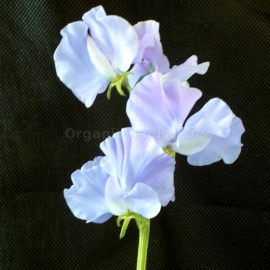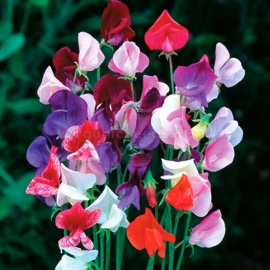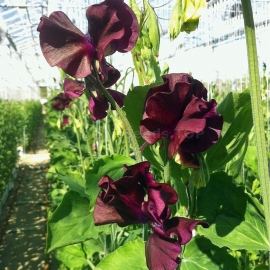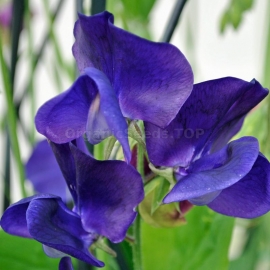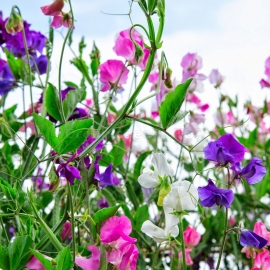





«Curly Mix» - Organic Sweet Pea Seeds
1.14 €
An annual climbing plant, up to 1-2 m high, the flowers are quite large, with a pleasant aroma, the plants are cold-resistant, photophilous, used for vertical gardening, as well as for bouquets.
-
Curly Sweet Pea (Mix) / Lathyrus odoratus
It is a climbing annual, growing to a height of 1-2 m when a suitable support is provided. Root system of rod type, deep, weakly branching.The flowers are quite large, with a pleasant aroma. Plants are cold-resistant, photophilous. Sow early in spring. Blooms 60-90 days after germination. Used for vertical gardening, as well as for bouquets.
The leaves are paired, consisting of two or three pairs of leaflets, ending in a tendril that clings to other plants that serve as its support.
The inflorescence is a few-flowered raceme emerging from the axils of the leaves. The flowers are irregular, quintuple type. The petals are lilac, 2-3 cm wide in wild plants, larger and very variable in color in many cultivated ones. The flower has a strong pleasant smell.
The calyx consists of five fused sepals; stamens 10, of which 9 fused; pistil one, ovary upper multi-seeded.
The fruit is a bean that opens in two leaves. The seed is spherical, large (4-5 mm), sometimes squeezed from one or two sides; the surface is slightly rough, without a pattern. Seed color from light yellow or light greenish to black-brown.
Sweet pea is a photophilous and heat-loving plant, it develops better in a temperate climate. In areas with arid and hot climates, sweet pea flowers become smaller, and buds, flowers and ovaries often fall off. The fall of flowers and buds is also observed with excessive moisture.
Sweet pea grows well in bright, sunny, open places and on humus-rich, neutral soils.
Sweet peas are self-pollinating plants. However, there is evidence that in hot dry climates it behaves partly as a cross. Therefore, spatial isolation when grown for seeds, depending on the climate, is different, in central Russia 3-5 m, in the south at least 50 m.
Seeds usually germinate in 14-15 days, but there may be a part of seeds that do not germinate for a long time, completely healthy-looking seeds, the so-called. "glass"; to speed up their germination, it is enough to pierce the seed coat with a needle. The optimum temperature for germination is 20°C.
Sweet peas have been cultivated since the 17th century and a vast number of cultivated plants are available. It is often grown in gardens as an ornamental plant for its bright flowers and fragrant scent, which gives it its name.
Henry Eckford (died 1906), a nursery worker on the Scottish slopes, crossed sweet peas from a rather unprepossessing but sweet-scented flower into a Victorian flower sensation.
His initial success and commercial flair helped him become Earl Randor's chief gardener and breed new varieties of pelargoniums and dahlias. In more recent times, the connection between sweet peas, the Eckfords, and Vam has been cast in a new light. In the late 1980s, the Wem Sweet Pea Society began an annual sweet pea show, and the city once again raised the flower to its height. Many of the city's streets feature the sweet pea motif, and a park in the city is named after Eckford.
With this product buy
Product code: 568
1.14 €
Royal Sweet Pea vines are an old-fashioned favorite, and they are prized for being so easily grown from Sweet Peas seeds and their charming, scented blooms. This lavender Sweet Pea has an average of 3 - 5 blooms in a cluster.
Product code: 569
1.14 €
Sweet Peas are a very colorful vining plant with large fragrant blooms, and they grow so easily from Sweet Peas seeds. The plant has long stems so it makes an excellent cut flower, and is a wonderful addition to any flower garden.
Product code: 1350
1.14 €
This very colorful maroon Sweet Pea is one of the best that Lathyrus Odoratus has to offer. This Lathyrus Royal maroon is quick to mature, and in approximately 8 weeks after sowing the Sweet Peas seeds, blooms will begin to emerge.
Product code: 10747
1.14 €
This dark colored Sweet Pea navy blue will be a deep purple or navy blue depending on soil nutrients. It is one of the darkest blue Sweet Peas in existence. Up to five large, wavy bloom clusters on long, slender stems.

